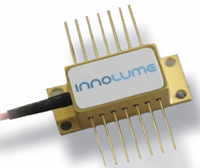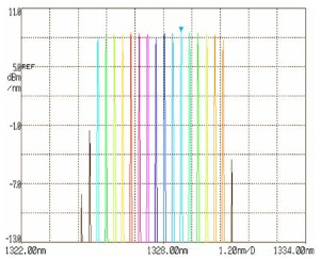
| Home | About Us | Contribute | Bookstore | Advertising | Subscribe for Free NOW! |
| News Archive | Features | Events | Recruitment | Directory |
| FREE subscription |
| Subscribe for free to receive each issue of Semiconductor Today magazine and weekly news brief. |
News
25 March 2008
Innolume launches comb laser diode for O-band WDM
Innolume, which manufactures quantum-dot (QD) laser diodes and modules operating at 1.05–1.32µm for medical, industrial, communications and computer applications, is sampling the new InnoComb, which it claims is the first diode laser to emit tens to hundreds of pure, low-noise colors (comb spectrum) from a single laser cavity.
 Powered by a single InnoComb, wavelength-division multiplexing (WDM) - previously restricted to telecoms due to the costly laser arrays required - can now be applied to low-cost, short-reach, high-bandwidth optical interconnects (e.g. in computers).
Powered by a single InnoComb, wavelength-division multiplexing (WDM) - previously restricted to telecoms due to the costly laser arrays required - can now be applied to low-cost, short-reach, high-bandwidth optical interconnects (e.g. in computers).
Picture: Innolume's pig-tailed comb laser.
Following last year’s demonstration of the first broad-spectrum Fabry-Perot (FP) laser (>70nm, Opt. Lett., 2007, 32, p793), Innolume says it has dramatically reduced the relative intensity noise (RIN) of each spectral line, culminating in the diode comb laser as a practical computer communications source.
“This laser innovation offers increased integration and functionality at reduced size and cost, i.e. using cavity resonance with QD gain behavior to replace laser farms or integrated laser arrays,” says president and CEO Jürgen Kurb. “Space- and cost-efficient WDM systems are enabled for the first time, offering new datacom opportunities with respect to cost, power and reliability,” he adds. “Additionally, the comb laser simplifies system design by virtue of all channels moving in unison with shifting temperature.”
InnoComb is a single FP laser emitting many lines/wavelengths/channels (longitudinal cavity modes) with nearly the same power on each. Innolume has demonstrated 10mW of power per channel over 16 channels, and >1mW/channel over 100 channels. Channel spacing is currently available from <50GHz to 140GHz (< 0.28nm to 0.8nm) centered at any wavelength between 1250nm and 1320nm.
For datacoms, the comb laser’s channels are separated (demultiplexed), modulated externally at ≥10Gb/s, and multiplexed for single-fiber transmission. External modulation on 16 comb channels was demonstrated by Fraunhofer Heinrich-Hertz-Institut (HHI), Berlin (Electron. Lett., 6 Dec. 2007, vol 43, 25, p1430), with error-free transmission (BER<10 -13) due to the exceptionally low RIN (~0.1%) on each lasing line.
“The diode laser as a multiple-wavelength source in high-speed communication systems has been something of a ‘holy grail’, but noisy longitudinal lasing modes in quantum well FP lasers made them a ‘no-go’,” says Dr Norbert Grote, head of HHI’s Laser Group. “In contrast, the comb lasers we tested from Innolume show eye diagrams for each line comparable to the best single-frequency extended cavity lasers (ECLs), thus opening great opportunities for efficient 1300nm WDM communication systems based on a single laser,” he adds.
Innolume originated as NL Nanosemiconductor, which was spun out of the Ioffe Physico-Technical Institute in St Petersburg, Russia in 2003 to its fabrication facility in Dortmund, Germany by founder Nikolai Ledentsov. Last January the firm renamed itself Innolume and established a headquarters in Santa Clara, CA, USA. “Ioffe graduates at Innolume have invented a new class of semiconductor lasers based on fundamental behaviors of quantum dots,” adds professor Zhores Alferov of Ioffe Institute, St.Petersburg, Russia (who won the 2000 Nobel Prize in Physics for developing the double heterostructure). “With their enablement of comb laser diodes, quantum dots have found their key differentiator from conventional quantum wells, with huge potential for practical implementations,” he adds. “Integration has been a major driving force for the electronic industry, and now quantum dot technology puts us on the same road, making it possible to embody hundreds of CW lasers inside a single diode laser cavity.”
“Our single InnoComb device relies on conventional FP edge-emitter fabrication processes, providing a highly leveraged alternative to proposed arrays of 16, 32, or even 100 DFB [distributed feedback] lasers,” says Innolume’s senior optical engineer Dongliang Yin. “Integrated DFBs can cost 10x more per laser than a single FP comb. The tradeoff is our need for an additional demultiplexer, an integrated AWG [arrayed waveguide grating], instead of multiple lasers.” QD comb lasers therefore provide an attractive light source for commodity applications including WDM for short-to-medium range, he adds. “In the long run, it also brings the right economics to future chip-to-chip optical communication. As silicon photonics technology matures to the point of economically managing light between processor chips, a single comb laser ‘power supply’, either off-chip or bonded to the silicon, will drive the many optical channels necessary for Terabit per second interconnects.”
Conventional quantum well diode lasers with or without mode-locking remain too noisy to be practical comb lasers for high-speed communication, concludes the firm. It claims that its quantum dot materials and laser designs overcome this deficiency for the first time, permitting novel applications. The bandwidth advantages of WDM can now be migrated from expensive telecom systems to very low-cost, short reach transceivers, alleviating cost/power/weight/volume issues with server and backplane interconnects. Ultimately, the comb laser could drive high-speed WDM interconnects in a photonics switching layer ‘under’ future multi-core computer processors, reckons the firm. According to architectural analyses by top-tier computer companies and academics, this would offer a 100x power advantage over projected electronics performance.

Chart: Typical log spectrum of packaged, pig-tailed comb laser. Spectrum shows 16 channels around 1328nm, spaced by 0.35nm (62GHz). Low RIN permits >10GHz Tx/channel.
See related items:
Innolume launches high-power 1.2µm broadband gain chip
Innolume develops quantum-dot SOAs
NL adds silicon photonics capabilities and changes name to Innolume
Search: Innolume Quantum dot Laser diodes
Visit: www.innolume.com